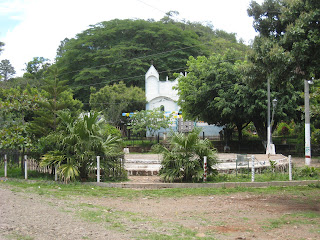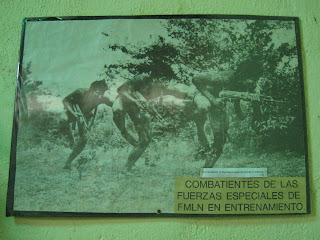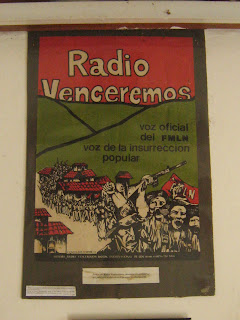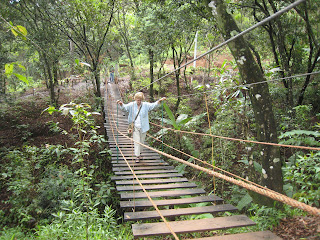We had a very long day today and were able to see lots of different things related to the Civil War and the massacre at El Mozote. Luis arrived with the microbus at the house and we left at 8:00am for the department of Morazán. We arrived at El Mozote (a massacre site) around 10:30am. This is my fourth trip to El Mozote and as I told the guide today, I always learn something new. The guide, named Trinity, told us the history of what happened there. The following is a description of the events at El Mozote. It comes from several sources, including information at the site and testimony by Rufina Amaya. I want to forewarn you that the story is graphic and disturbing.
The Massacre at El Mozote
The El Mozote Massacre took place in the village of El Mozote, in Morazán, El Salvador, on December 11, 1981, when Salvadoran armed forces trained by the United States military killed at least 1000 civilians in an anti-guerrilla campaign. It is reputed to be one of the worst such atrocities in modern Latin America history.
It began on the afternoon of December 10, 1981, when units of the Salvadoran army’s Atlacatl Battalion arrived at the remote village of El Mozote. The Atlacatl was a “Rapid Deployment Infantry Battalion” specially trained for counter-insurgency warfare. It was the first unit of its kind in the Salvadoran armed forces and was trained by United States military advisors. Its mission, Operación Rescate, was to eliminate the rebel presence in a small region of northern Morazán where the FMLN (guerillas) had a camp and a training center. The commander of the Battalion was Lieutenant Colonel Coronel Domingo Monterrosa Barrios, who was from Berlín.
In the afternoon of December 10th the five companies of Atlacatl Battalion arrived in El Mozote. Upon arrival, the soldiers found not only the residents of the village but also campesinos (rural people) who had sought refuge from the surrounding area. The campesinos had gone to El Mozote thinking it would be a safe place. The soldiers ordered everyone out of their houses and into the square. They made them lie face down, searched them, and questioned them about the guerrillas. They then ordered the villagers to lock themselves in their houses until the next day, warning that anyone coming out would be killed. The soldiers remained in the village during the night.
Early the next morning, on December 11th, the soldiers reassembled the entire village in the square. They separated the men from the women and children and locked them all in separate groups in the church, the convent, and various houses. At 8:00am the executions began.
Throughout the morning, they proceeded to interrogate, torture, and execute the men and adolescent boys in several locations. Around noon, they began taking the women and older girls in groups, separating them from their children and machine-gunning them after raping them. Girls as young as 9 were raped and tortured, under the pretext of them being supportive of the guerillas. Finally, they killed the children. A group of children that had been locked in the church and its convent were shot through the windows. After killing the entire population, the soldiers set fire to the buildings. Over 1000 people perished.
The massacre at El Mozote was part of a military strategy of genocide against the Salvadoran people. The government and army exterminated massive numbers of innocent campesinos in the war zones. The thought was to “take away the water from the fish”. As a result, many massacres of hundreds of rural families were carried out in various places in the country. The operations were known as “Land Clearing Operations”.
The guerrillas' clandestine radio station began broadcasting reports of a massacre of civilians in the area. On December 31, the FMLN issued “a call to the International Red Cross, the OAS Human Rights Commission, and the international press to verify the genocide of more than 900 Salvadorans” in and around El Mozote. Reporters started pushing for evidence.
Officials from the US embassy in San Salvador played down the reports and said they were unwilling to visit the site because of safety concerns. As news of the massacre slowly emerged, the Reagan administration in the United States attempted to dismiss it as FMLN (guerilla) propaganda because it had the potential to seriously embarrass the United States government because of its reflection of the human rights abuses of the Salvadoran government, which the US was supporting with large amounts of military aid.
It wasn’t until 1992, the year the Peace Accords were signed, that a team of forensic anthropologists were allowed to examine the convent in El Mozote. 136 children were found in that area. They determined that twenty-four shooters killed the children, using M-16 rifles and bullets manufactured in the US. The forensic experts concluded that it was a mass execution, and not the burial ground the Salvadoran government claimed it to be.
Rufina Amaya’s story
Rufina Amaya was the only survivor of the massacre. When it came time to execute the women, she stood last in line because she wouldn’t let go of her children. After her daughter was taken from her and the men weren’t watching, she hid nearby, praying the whole time for God to protect her. She stayed there a long time until she had the courage to crawl many miles to safety. No words or pictures could possibly describe how she felt that day: Listening to the screams of her husband being tortured and dying, having her children ripped from her arms and ruthlessly slaughtered. On December 11, 1981 she lost her husband and four children, aged 9 years, 5 years, 2 years, and 8 months.
El Mozote
Memorial at El Mozote
They have not died
They are with us
With you
And with all humanity
The names of the adults that died at El Mozote
Rufina Amaya's grave
Talking to Luis
Kathy and Luis
Seeing the Destruction
After telling us the story of what happened at El Mozote Trinity took us for a short walk to see some of the buildings that had been damaged during the massacre. Most of what remained were the shells of houses. You could see bullet holes in the walls of the houses though not much was left since they had been burned. Trinity pointed out to us in which houses the women died and where the men died. I’d never been to see these houses before so I was glad we were able to take the time to see them.
Soon we came upon the area where Rufina hid in the grass and plants. Trinity showed us the road where she escaped, crawling alongside the cattle to avoid being seen by the soldiers. Today we learned that the same day as the massacre a 500 pound bomb had been dropped near El Mozote. Trinity told us where it was and we went to go see it. It was hard to get a good picture but it was a big hole. It used to be bigger but over the years dirt had washed into the area and made it shallower.
One of the buildings damaged in the war
Bullet holes
This is one of only a few buildings that survived the massacre
Another devasted area
Most of the town was burned down
Where Rufina Amaya hid to escape from the soldiers
The road where Rufina crawled away
Mom standing near where the bomb was dropped
Church & Children’s Garden
Trinity led us back to the main area and pointed out two broken parts of columns that were a part of the old church before it was burned down. Part of the baptismal font also remains in the area. The new church was built close to where the old one was before the massacre. Next we went inside a little garden known as the children’s garden. During the massacre the children were all put into a room attached to the church. Here they were killed and the building set on fire. A small garden now grows where they found the remains of the children.
On the side of the church inside the garden are the names of all the children that were killed in the massacre and their ages. Most were under 12 years old. The youngest child killed was 2 days old though there was a pregnant woman in her third trimester who was found with the murdered women. While many names are on the wall several children’s names will be forever unknown. Entire families were killed in the massacre and the names of their children are not known. They are listed on the wall as “Son of…” or “Daughter of…” while others are listed “Grandson of…” or “Niece of….” However, there are also several children who are listed only as “Name unknown.” It’s sad to think that these beautiful children suffered such a horrible death and we will never know who many of them are.
After the tour was over we thanked Trinity. Today I learned that Trinity’s grandparents, aunts, uncles, and her father were killed at the massacre. She is now part of a group of 10 women who run the El Mozote Foundation which helps keep the area maintained and ensures the story is still being told. Then we walked to the little artisan store that’s run by the women of the Foundation. My mom got a water bottle holder and a pair of earrings and I bought a book about the department of Morazán during the Civil War. (The town of El Mozote is in the department of Morazán). Soon it was time for our next destination.
Trinity in front of the new church
The Children's Garden
In 1992 in this place the remains of 148 people were found,
140 of whom were under 12 years old.
All who were found are now buried in this monument.
The top name reads: Nina (nombre no conocida)
Girl (name unknown)
She was 13 years old
The names and ages of some of the youngest children.
The youngest shown on this plaque is 3 days old
Showing us a mural on the other side of the church
The bells from the old church
Another abandoned building
Río Sapo
We continued on to the Sapo River because Luis recommended it and we’d never been to this particular area before. It was a beautiful area with lots of water. We walked around for a while taking pictures and watching the water. I liked climbing around on the rocks and exploring the area. In spot area Luis pointed out an old bridge nearby that was built and used by the guerillas during the war. It wasn’t really stable so I didn’t walk across it but I did stand on it for a photo op. By then it was getting close to noon so we went to go eat lunch.
The Rio Sapo
The bridge we were just on
Flowing water
Walking around
Blanca & Idalia
Matt and I by the river
Taking pictures
We love it here!
The parents
It's almost time to head back
A bridge used during the war by the guerillas
It's an old bridge
I didn't go all the way across
because Luis said it was unsafe
Lunch at Perkin Lenca
We ate lunch at our usual spot: Perkin Lenca. It felt good to sit down and have a rest. I ordered my usual which is a Coke, steak, and French fries. The steak here is not at all like steak in the US, especially Iowa steak. It’s thinner and usually much more well-done. The meat here needs to be cooked longer to kill any bad things in the meat. Before the meal they brought out some fried tortillas pieces and beans. Yum! Then the meal came. It was all delicious and I scarfed down my food. Afterwards I bought some of the cookies they make at the restaurant that I really like. By the time we were ready to leave it had started raining. We hoped for the best and got back into the microbus.
Storm clouds rolling in
At the restaurant
Perquin: Museum of the Revolution
Our next stop was the town of Perquin. Perquin was under guerilla control during the Civil War and was known as part of the “red zone”. First we visited the Museum of Salvadoran Revolution. It contains documents, articles, pictures, and artifacts that belonged to the guerillas during the Civil War. The museum was founded by ex-combatants and attempts to recount the experiences of the guerillas. I asked if we could take photographs even though they have never let us take pictures inside the museum before. And I was pleasantly surprised when our guide said yes! This was a first. I whipped out my camera and took pictures of all the things I’ve wanted to take pictures of in the past.
After looking through the inside of the museum we walked outside to see the remains of helicopters and airplanes. Probably the most famous is the wreckage of the helicopter of Colonel Domingo Monterrosa, who was the commander of the Battalion that massacred the people in El Mozote. It was blown up by the guerillas in 1984. We also saw a recreation of Radio Venceremos, which was a mobile guerilla radio station during the war. Inside the recreated radio station is part of the device that was used to destroy Monterrosa’s helicopter.
Inside the museum in Perquin
Causes of the war: We are poor
Plaque for the heroes and martyrs
Naked innocence, faceless repression
Near the Cathedral in San Salvador
Poster from the 1980s
El Salvador will win with your help
Poster in German about stopping
US intervention in El Salvador
Medicines and supplies used by the guerillas
Guerilla group
There were many female combatants as well
Woman were trained to use guns
Guerilla strategic attack map
They wrote in code
More code
Weapon used by the guerillas
Famous photo
I was really excited to take photos
Cockpit seat of a plane
Hugging after the Peace Accords were signed
More arms
Lots of women guerillas
Inside the museum
The wreckage of Monterrosa's helicopter
Mortar launchers
Part of a 500 lb bomb
Inside the Radio Venceremos recreation
The radio used to blow up Monterrosa's helicopter
Poster in the radio station
The radio station
A 500 lb. bomb that never exploded
Guerilla Encampment
Next we went to Campamento Guerrillero, which was a former guerilla camp turned into an outside museum. I’ve been there a couple times before and loved it. First we saw some of the weapons they used during the war including grenades, machine guns, and machetes. We walked on to see two recreated “tents” where the guerillas could stay dry when it rained. Then we went to the “kitchen” area which they tried to hide so as not to be seen by the military. Over the kitchen was a roof of leaves and a pipe underground carried the smoke far from the kitchen. After that we saw the “hospital” area. The gurney was essentially large leaves wrapped around sticks that were being held up by pieces of wood. Our guide showed us the “ambulance”: a hammock. The first time I saw it Kathy had asked me, “Could you imagine being operated on here?” I responded, “I think I’d rather die.” We walked on to a hole in the ground with a ladder coming out of it. It led down to an underground chamber and tunnel. This was a place the guerillas would have hidden if there were helicopters overhead.
Next we came to a series of three bridges. These were replicas of bridges that the guerillas would have built while in the area. Typically, the guerillas would only stay in each area for 4 days. Then they would transport what they could and destroy the rest. The bridges were destroyed and rebuilt every time they moved. All were made of wood and rope over high ravines. After looking at a sign that said, “Only 2-3 people at once on the bridge” and “We’re not responsible if you fall” we crossed over the first bridge. Everyone did very well and no one fell off. The second bridge was made only of wood and wasn’t as long as the first. The final bridge swayed and dipped down quite a bit when we walked on it, but we all made it.
We then walked by a sign that said, “Look, don’t touch”. Lying on the ground was a grenade that had never exploded. It has been sitting there for many years. The reason we couldn’t touch it was that it was technically still live. Now would it actually have exploded? I’m not sure. But I didn’t want to find out. After that we saw a bomb that had been partially embedded in a tree. Several of the pieces had been pulled out of the tree but one piece they weren’t able to remove. And with that we had reached the end of the tour. We heard thunder coming so we hurried to the microbus.
Grenades used during the war
Photo of our guide's father during the war
Recently discovered pieces of weapons
Luis demonstrating how to use the machine gun
The hospital
Underground hiding area
Hiking up the hill
Mom crossing the first bridge
Dad crossing the first bridge
Alisha crossing the last bridge
Here comes Luis
You can do it, Matt!
Kathy posing for the picture
A grenade that never exploded
Pineapple!!
Bombs discovered in the area
Rufina Amaya’s house
We made one more stop as we drove back to Berlín. It was a place Luis knew about that none of us, not even the ladies, had been to before. It was Rufina Amaya’s old house that had been turned into a little museum. Her daughter was there and explained to us the things on the walls. There were several photos of Rufina at various points in her life after the massacre. She traveled to many places in order to tell her story. Many photos were taken when Rufina first went back to El Mozote and of her observing the exhumations. Her daughter also had some of Rufina’s clothes, shoes, TV, an old sewing machine, and a scale she used to weigh food. It was very interesting a definitely worth the stop. I’m glad Luis knew about the place.
Rufina Amaya's old home, now a museum
Photo of Rufina outside the museum
Photo of El Mozote after the massacre
Rufina visiting El Mozote for the first time
Excavations
Rufina by the memorial plaque
Publicly telling her story
Another photo of Rufina
Rufina's sewing machine
Holding up her mom's scales
Inside the museum
Showing us a newspaper article about her mom
It took a couple more hours to get home and we were all exhausted after the long day. But there was a little more information we wanted to share with my family. Kathy read a Bible verse to the group. It was Psalm 10:
“Why, LORD, do you stand far off? Why do you hide yourself in times of trouble?
In his arrogance the wicked man hunts down the weak, who are caught in the schemes he devises. He boasts about the cravings of his heart; he blesses the greedy and reviles the LORD. In his pride the wicked man does not seek him; in all his thoughts there is no room for God. His ways are always prosperous; your laws are rejected by him; he sneers at all his enemies. He says to himself, “Nothing will ever shake me.” He swears, “No one will ever do me harm.”
His mouth is full of lies and threats; trouble and evil are under his tongue. He lies in wait near the villages; from ambush he murders the innocent. His eyes watch in secret for his victims; like a lion in cover he lies in wait. He lies in wait to catch the helpless; he catches the helpless and drags them off in his net. His victims are crushed, they collapse; they fall under his strength. He says to himself, “God will never notice; he covers his face and never sees.”
Arise, LORD! Lift up your hand, O God. Do not forget the helpless. Why does the wicked man revile God? Why does he say to himself, “He won’t call me to account”? But you, God, see the trouble of the afflicted; you consider their grief and take it in hand. The victims commit themselves to you; you are the helper of the fatherless. Break the arm of the wicked man; call the evildoer to account for his wickedness that would not otherwise be found out.
The LORD is King for ever and ever; the nations will perish from his land. You, LORD, hear the desire of the afflicted; you encourage them, and you listen to their cry, defending the fatherless and the oppressed, so that mere earthly mortals will never again strike terror.”
It is a powerful verse and normally Kathy reads it at El Mozote but we forgot the book. After that my family watched the documentary about Rufina Amaya called “I am Not Afraid.” In that 30-minute film she walks through El Mozote and tells the story of what happened during the massacre. This film was especially powerful after having just visited El Mozote and Perquin. To watch the film please visit this website: http://www.memoriaypaz.net/repression1.php?testi_id1=1003
Suggested further reading
The Massacre at El Mozote – Mark Danner
































































































3 comments:
Another interesting and moving day. Again it was tough to take in all that we learned. It was great to stop by the Rio Sapo, that was really a nice diversion.
Mucho gracias,thank you for posting the pictures of the conflict.They are hard to look at,for myself and close friends who have after all this time are "in the battle" Vaya con dios.Ciao
Post a Comment